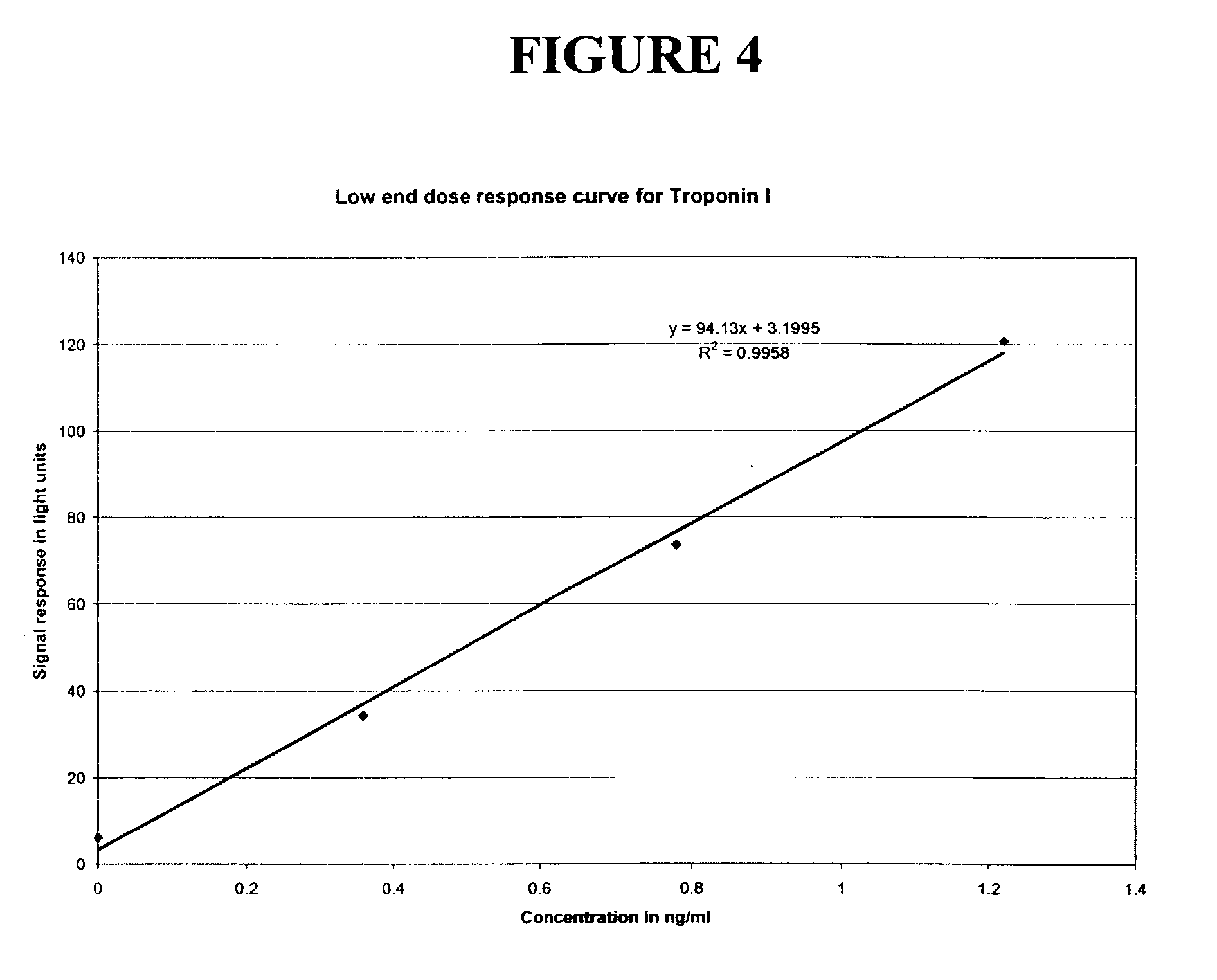[0047] As the plot in FIG. 4 demonstrates, if the line approaches horizontal one will be working with less signal and therefore have inherently more imprecision. If one were to employ a wash method that produced a more precise
signal response but did this at the expense of reducing half of the
usable signal in the
critical range, then there would be little or no benefit unless the improvement is significantly better than 2×. An
advantage of the present invention that there is a significant improvement in low end precision without reducing the amount of
usable signal. This aspect of the invention is useful in any analysis that may have an interfering undersired component on the surface of the sample holder, such as a well or
cuvette described above. The timing of the
surface film removal depends on the
system and
chemistry being employed. If
immunochemistry were employed, the removal would be after addition of signal
reagent and any incubation. This incubation is expected to enhance the amount of material that becomes dislodged from the surface. It may also
impact the amount of material that floats to the surface. It would be expected that the effectiveness of this process is greatest after some
incubation period. Chemiluminescent (
immunochemistry) assays will have this
incubation period and not produce a buildup of signal since this type of process only produces light.
[0048] An
advantage of the surface removal embodiment (hereinafter also referred to as the aspirate or aspiration embodiment) that employs an incubation of a signal producing reagent is that it enables an overall shorter
time to result and better
system throughput for the equivalent amount of wash efficiency. This is because the aspirate embodiment makes double use of the signal reagent incubation by turning signal reagent incubation into a supplemental wash process (soak) while incubating at the same time. For example, in a preferred embodiment described above, there is generally a total of 120 seconds of soak time between washes (3 soaks at 40 seconds each). With the preferred aspiration process, an additional soak time of 4 minutes and 40 seconds is added (i.e., the signal incubation time in certain embodiments) is provided resulting in a greater than 4 times increase for soak time. Thus, there is a longer effective wash / soak time for the embodiments that use the aspiration process compared to an equivalent method but does not employ the aspiration process.
[0049] If the analysis is a calorimetric analysis having a dye detection system, the
surface film or layer should be removed before the endpoint color is measured. A dye detection system results in a buildup of color density with time if there is signal producing material present. Thus, if the aspirate embodiment is used in a calorimetric type
assay the method will be somewhat modified. For example, the surface of the fluid may be aspirated multiple times during the detection incubation process. Another alternative would be to put in a wash fluid and aspirate the surface after an incubation time. An
advantage of this method over the current state of the art methods having an extended wash soak time is that aspiration of the
surface film before removal of the bulk fluid would be expected to remove a concentrated layer of unbound material. This unbound material could get re-deposited on the surface of the container using conventional aspiration methods where an aspiration
nozzle removes the bulk fluid without first selectively removing or aspirating the surface film.
[0050] The ultimate timing of the surface film removal depends on the system and
chemistry being employed and can be determined by those skilled in the art using the present specification as a guide.
[0051] In a particularly preferred embodiment, the processes described above are employed in an immunodiagnostic
assay analyzer, such as those described in U.S. Pat. No. 6,069,561 and copending U.S. application Ser. No. 09 / 482,599 filed Jan. 13, 2000 entitled “Failure Detection in Automated Clinical Analyzers,” both of which are incorporated by reference in their entireties. In preferred immunodiagnostic analyzers, the container is cup-shaped. Preferred containers are 0.35 ml, conical containers coated with a material complementary to the reagents. Container coatings can comprise materials such as
streptavidin and / or other materials useful for immunochemical analysis as is well known in the art to facilitate binding by a biotinylated
antigen or
antibody to which an analyte binds as part of the assay
chemistry. An exemplary container 10 is shown in FIG. 1. Also preferred are separate wash dispense and aspirating probes, such as the wash dispense 20 and aspiration nozzles 30 in wash unit 40 shown in FIG. 2.
[0052] In a typical immunodiagnostic analyzer, the analyzer is categorized into systems and subsystems of components that perform different processes in the sequence of measuring a sample for an analyte, such as those described in the '599 application. A typical process involves a sample being dispensed into a container that may or may not already have a reagent present in the container that is dispensed by a reagent metering system. After the reagent is added, the sample is diluted, if necessary, and then incubated. After incubation, the container is washed, in this instance according to the inventive wash. After washing, a signal reagent is added, followed by further incubation, if necessary, optionally followed by the surface removal embodiment. The signal produced by the combination bound analyte / signal reagent is read by the appropriate
detector, e.g., a luminometer.
 Login to View More
Login to View More  Login to View More
Login to View More 


